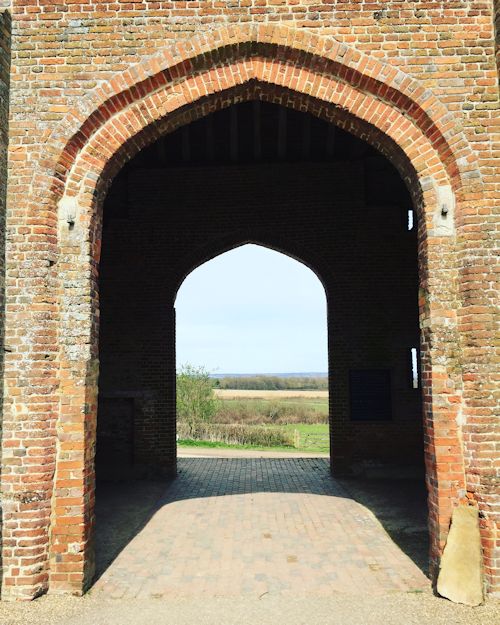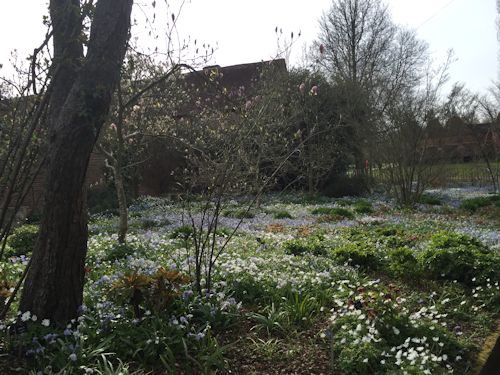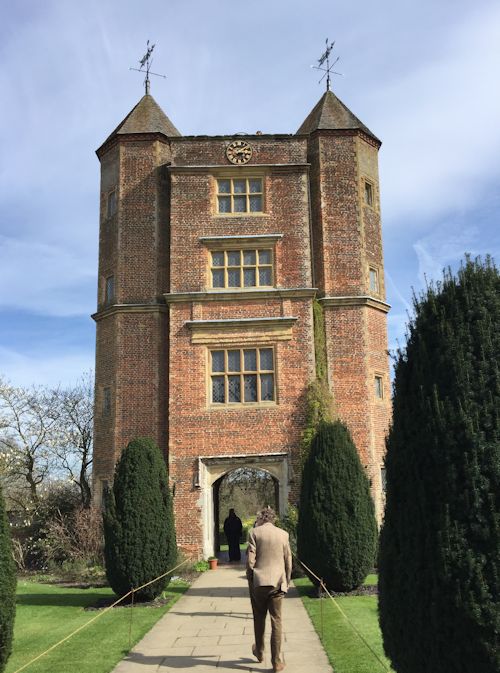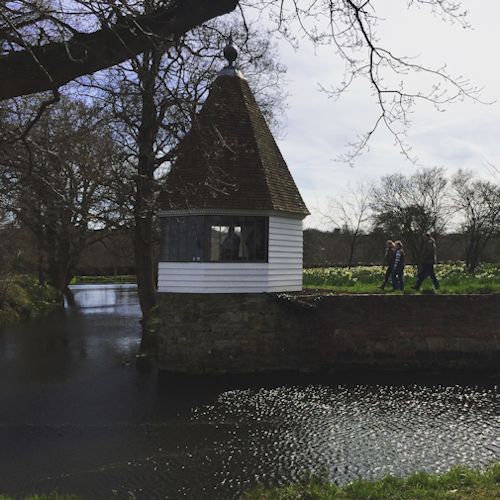Sissinghurst Castle
"The most noteworthy thing about gardeners is that they are always optimistic, always enterprising, and never satisfied. They always look forward to doing something better than they have ever done before."
Vita Sackville-West

When you're driving along the long road which leads to Sissinghurst Castle, you try to spot the tower. With each turn, your eyes gaze over the horizon and you wonder where it is until finally, it's there.
Sissinghurst Castle is famous now for its garden, created by Vita Sackville-West and Harold Nicolson in the 1930's.
Harold was a diplomat, politician and author. He had a number of controversial affairs, including homosexual liaisons, which was illegal at the time. Vita was a poet and gardening writer (incidentally also known as the androgynous protagonist in Orlando: a Biography, written by Virginia Woolf, with whom she had an affair). To say that Vita and Harold's marriage was unorthodox is an understatement. These days we would refer to their relationship as being 'open'. In those days it was unheard of.

The White Garden
The garden itself is split into various 'Rooms', each with its own unique character and theme. A favourite of mine was the White Garden. The abundance of flowers in the White Garden was extraordinary, with each being white or pale blue.
If you're anything like I am, you will wonder what time of year is best to see the gardens at Sissinghurst Castle. And that's why I found myself waiting diligently for the welcome talk, hoping that I would have the opportunity to ask the volunteer this question.
'The history of Sissinghurst goes back so far and deep, that it is almost impossible, to sum up in fifteen minutes,' she began, and I listened as she flawlessly recited names and dates and imparted most of the important facts about Sissinghurst.
This is what the National Trust volunteers do best. According to the National Trust website, they have over 60,000 volunteers. That's a staggering number. If the National Trust was a town, measured by population it would be the 161st largest in the UK, above Loughborough and below Wallasey.
As she began talking, I discovered that she was right: Sissinghurst's history was vast.
The site itself is ancient. The original name for where Sissinghurst now stands was Saxonhurst. 'Hurst' is a Saxon term for an enclosed wood. It is known that a Manor House was built here in the Middle Ages.
The home was owned by pig farmers, and then the de Berham family. They were clearly successful. The house is built of brick, which at the time was an expensive and rare material to build with. To construct a house of this size with brick was a statement of sorts, perhaps the same as wearing a Rolex watch or driving a Bentley is today.

Sissinghurst eventually fell into the hands of the Baker family. Sir John Baker, one of Henry VIII's Privy Councillors, owned the property and subsequently went to work building a new gatehouse.
Sir John Baker himself was an interesting and influential figure. At one time he was Chancellor of the Exchequer, after being Speaker of the House of Commons. He was also sworn to the Privy Council of Henry VIII, Edward VI, Mary and Elizabeth I, which was no small feat. Sir John Baker's name lives on in Bakers Cross in Kent.
When Baker died, he left Sissinghurst to his son, Sir Richard Baker.
Sir Richard Baker enlarged the property a great deal, to the extent that it was eventually a deer park of some 700 acres. Queen Elizabeth I spent three nights at Sissinghurst in 1573.
In 1661, after Sir Richard Baker's death, another Sir John Baker came into ownership of Sissinghurst. When Sir John Baker died, he left four daughters, and no male heirs.By 1730 there were no descendants of the Baker family. The estate was sold to Sir Horace Mann.
Sir Horace Mann enjoyed spending his time in Florence and consequently never lived in Sissinghurst. During this period, Great Britain was involved in the Seven Years' War (much of the rest of the world was involved in the conflict too: Winston Churchill referred to the Seven Years' War as the 'First World War'). Spotting an opportunity, Mann leased Sissinghurst to the Government and the building was used as a prisoner of war camp, housing French troops.
When the French prisoners wrote home to their families, they would refer to the house as 'Chateau de Sissinghurst'. The name stuck, and we now know the property as Sissinghurst Castle.
Those were dark days for Sissinghurst, and large amounts of history were lost during this period. Wood from the home was torn down and burnt to keep the occupants warm and the French inmates were treated badly by the guards. The house turned to ruin.
The Parish of Cranbrook took out a lease on Sissinghurst in 1796. They converted the property into a poor house, housing 100 men and providing them with food and employment.
In the 19th Century, the building was owned by the Mann Cornwallis family. Thankfully, they undertook repairs and restoration work. Their tenure at Sissinghurst Castle was productive and has allowed subsequent owners to build upon their legacy. There is a nod to them on top of the main towers, upon which sits a weather vane, inscribed with the initials 'MC 1839'.
Despite the restoration work undertaken by the Mann Cornwallis family, Vita and Harold in 1930 found Sissinghurst in a derelict state.
For Vita, ownership of Sissinghurst would be poetic. Had she been male, she would have inherited Knole, reportedly the largest home in England. Unfortunately for Vita, however, the Sackville-West tradition was to follow the 'Salic rules of primogeniture', so her father Lionel, the 3rd Lord Sackville, bequeathed the estate to his brother.
You can imagine her delight when she discovered that in fact she had a link to Sissinghurst: a former owner of Sissinghurst, Sir John Baker, married Catherine Sackville circa 1520.
Upon moving into Sissinghurst, Vita and Harold started renovation works and begun designing the garden as we know it today. The layout was designed by Harold and the planting conducted by Vita.
And the gardens are spectacular. Each 'Room' has a different atmosphere, and they are separated by sharply cut hedges and brick walls. The amount of work and effort which goes into maintaining these gardens is astonishing. There are copious amounts flowers, even popping above the ground around the base of trees. At this time of year, the daffodils and tulips have to be dead-headed each week. The gardeners begin planning the Room designs in the summer months. When the bulbs are delivered they are either planted straight into the flower beds or potted and stored in frames in the Nursery. This year, the gardeners have ordered 36,000 bulbs.

Gazebo on the edge of the moat
Both Vita and Harold died at Sissinghurst, 30 years after opening their garden up to the public for the first time. In Harold's honour a gazebo on the edge of the moat was built by his children. It is interesting to note that the structure has the exact same dimensions as Apollo 11.
After the allotted fifteen minutes had passed and the welcome talk came to a close, we were asked if we had any questions.
'When's the best time of year to visit?' I asked.
'Any time,' the National Trust volunteer said. 'This time of year is beautiful, with the spring flowers surfacing through the ground. Of course, June and July is when the roses bloom, which is a spectacular sight. And the colours in the autumn are stunning. There really is no "best time" to visit Sissinghurst. It's always perfect.'
And that is the brilliance of Sissinghurst.
By Toby Sligo; Knowledge of London National Trust Reporter
London Time
 The contents of this website are the property of knowledgeoflondon.com and therefore must not be reproduced without permission. Every effort is made to ensure the details contained on this website are correct, however, we cannot accept responsibility for errors and omissions.
The contents of this website are the property of knowledgeoflondon.com and therefore must not be reproduced without permission. Every effort is made to ensure the details contained on this website are correct, however, we cannot accept responsibility for errors and omissions. Contact Us | Advertise
Contact Us | Advertise